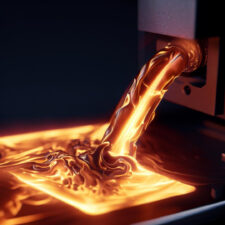Fused deposition modeling (FDM) is a popular 3D printing technology that uses thermoplastic filaments to create 3D objects. One of the most commonly used materials in FDM is acrylonitrile butadiene styrene (ABS).
ABS is a thermoplastic polymer that is widely used in many industries due to its strength, durability, and resistance to impact and heat. It is also a popular material for 3D printing because of its ability to be melted and extruded through a 3D printer nozzle.
How FDM with ABS Works
During FDM with ABS, the printer heats the ABS filament to its melting point and then extrudes it layer by layer onto a build platform. The layers of ABS are fused together as they cool, creating a solid 3D object.
The build platform is usually heated to prevent warping and improve adhesion. This is especially important with ABS, as it can be prone to warping and cracking during printing if the temperature is not controlled properly.
Advantages of FDM with ABS
FDM with ABS offers several advantages over other 3D printing technologies and materials:
Strength and Durability
ABS is known for its strength and durability, making it a popular choice for creating functional parts and prototypes. FDM with ABS produces parts that are sturdy and long-lasting.
Heat Resistance
ABS has excellent heat resistance, making it ideal for parts that will be exposed to high temperatures. This makes it a great option for creating parts for machinery, automotive, and aerospace industries.
Versatility
ABS is a versatile material that can be easily modified with additives and colorants. This allows for a wide range of customization options when creating parts and prototypes.
Cost-Effective
ABS is an affordable material, making it a cost-effective option for creating prototypes, models, and small-scale production runs.
Challenges of FDM with ABS
While FDM with ABS offers many advantages, there are also some challenges to consider:
Warping
ABS is prone to warping during printing, especially if the temperature is not properly controlled. This can cause parts to warp or crack, leading to failed prints.
Smell and Fumes
ABS can produce a strong smell and fumes during printing, which can be unpleasant and even harmful if not properly ventilated.
Post-Processing
ABS parts often require post-processing, such as sanding or smoothing, to achieve a polished finish. This can be time-consuming and labor-intensive.
Tips for Successful FDM with ABS
To ensure successful FDM with ABS, follow these tips:
Temperature Control
Proper temperature control is essential when printing with ABS. Make sure the build platform is heated and the printer is set to the correct temperature.
Bed Adhesion
To prevent warping, ensure good bed adhesion by cleaning the build platform and using adhesives such as glue or hairspray.
Ventilation
Proper ventilation can help reduce the smell and fumes produced by ABS. Consider printing in a well-ventilated area or using a printer with built-in ventilation.
Post-Processing
Plan for post-processing by sanding or smoothing the finished part. This will improve the overall look and feel of the part.
Conclusion
FDM with ABS is a popular 3D printing technology that offers strength, durability, and versatility. While it can be challenging to print with, following these tips can help ensure successful prints with ABS.

